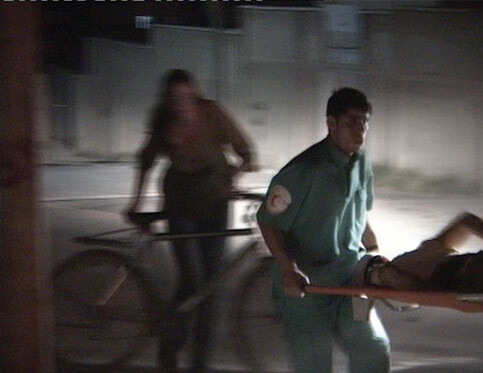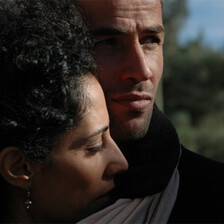The Electronic Intifada 1 December 2006

A still from “Visit Palestine”
Katie Barlow’s documentary Visit Palestine was one of the most riveting films to be featured in this year’s Chicago Palestine Film Festival. In the film Barlow follows Irish human rights activist Caoimhe (pronounced Cueeva) Butterly during her stay in Jenin refugee camp in 2002. Among her extensive involvement in the Jenin community, Butterly worked with local volunteers shortly after the 2002 massacre, unearthing the bodies of over sixty civilians who had been killed in the incursion. Butterly’s willingness to risk her own safety to intervene in and witness the ongoing assault on Palestinian civilian life gained her the respect and trust of Jenin residents, as she was welcomed into the homes of several families.
Through interviews and footage of residents living under daily military siege, what first appears as the story of a peace activist determined to take direct action quickly turns into a candid and tragic portrait of a people enduring the suspension of all their human and civil rights. As Butterly’s experiences of living in occupied Palestine are relayed, a strong sense of urgency is communicated through footage of the perpetual state of chaos residents of Jenin are subjected to. A continual stream of scenes showing women and children dodging gunfire as tanks barrel down city streets inform the viewer of the immediacy that first drove the then twenty-three year old to the village in 2001.
Butterly’s commitment to social justice spans several years of working with local community members and activists in numerous conflict-ridden nations. The focus of her work has been what she describes as “working with and providing direct accompaniment for grassroots, local initiatives working towards sustainable forms of development, human and civil rights.” In Jenin, Butterly’s work served not only to assist in the much needed humanitarian aid provided by international and local organizations but also to ease the growing isolation Palestinians feel, as they experience the muting of their struggle to end the occupation.
Although she offers her own insight into life under the occupation, she is careful not to overstep her boundaries as an activist, emphasizing and acting on her role as a witness in solidarity with Palestinian civilians. As Barlow accompanies her during a portion of her stay in Jenin, Butterly makes a concerted effort to dispel Western misconceptions of Palestinian civilian life by articulating the severity of the occupation and the greater sociopolitical context in which impassioned testimonials of anger, sorrow and devastation are conveyed. Butterly’s narration is eloquent, introspective and sincere, drawing the viewer into the most impacting aspect of Barlow’s film, the revealing footage of the life-threatening conditions of the Israeli occupation in which the IDF is constantly targeting civilians and disrupting every aspect of Palestinian daily life.
With her own understanding of her role as a witness, Butterly often placed herself in dangerous situations when her presence acted as a physical hindrance to military fire. Walking children to school, accompanying women to buy groceries and standing in front of tanks while shot at by IDF soldiers, exemplifies the lengths to which she understood the importance of her presence in the camp. In one scene Butterly comments on the blatant racism of the occupation, stressing that as a foreigner and a woman she is privileged with the likelihood of soldiers not shooting her. As the film delves deeper and the viewer is shown the extent to which she is rooted in the community, we find that even her ethnicity and gender, which might have discouraged Israeli soldiers early on for fear of backlash from the international community, no longer places an invisible shield around her. Butterly was made an example and was shot in the leg at close range in November 2002.
The cinematography, with its intensity of color saturated scenes, combined with compositions in which the camera is allowed to enter the most intimate of spaces, highlights a complex dimension of the film. In the film the camera takes on the same role of witness as Butterly herself. Several scenes shot in the homes of residents are captured with the camera as a welcomed fixture in the private domain. The sense of mutual trust and respect that is apparent between Butterly and the families she has befriended is extended to Barlow and her camera. This allows Barlow to capture moments in which subjects are frank and uninhibited in their discussion of the occupation and its effects. Conversations (mostly among women and children) that would take place in the most sacred of spaces within a community are allowed to be filmed, giving a rare look into Palestinian life in the occupied territories.
Maymanah Farhat is a freelance writer and researcher of visual arts and culture, and is a specialist in Modern and Contemporary Arab art.
Related Links





